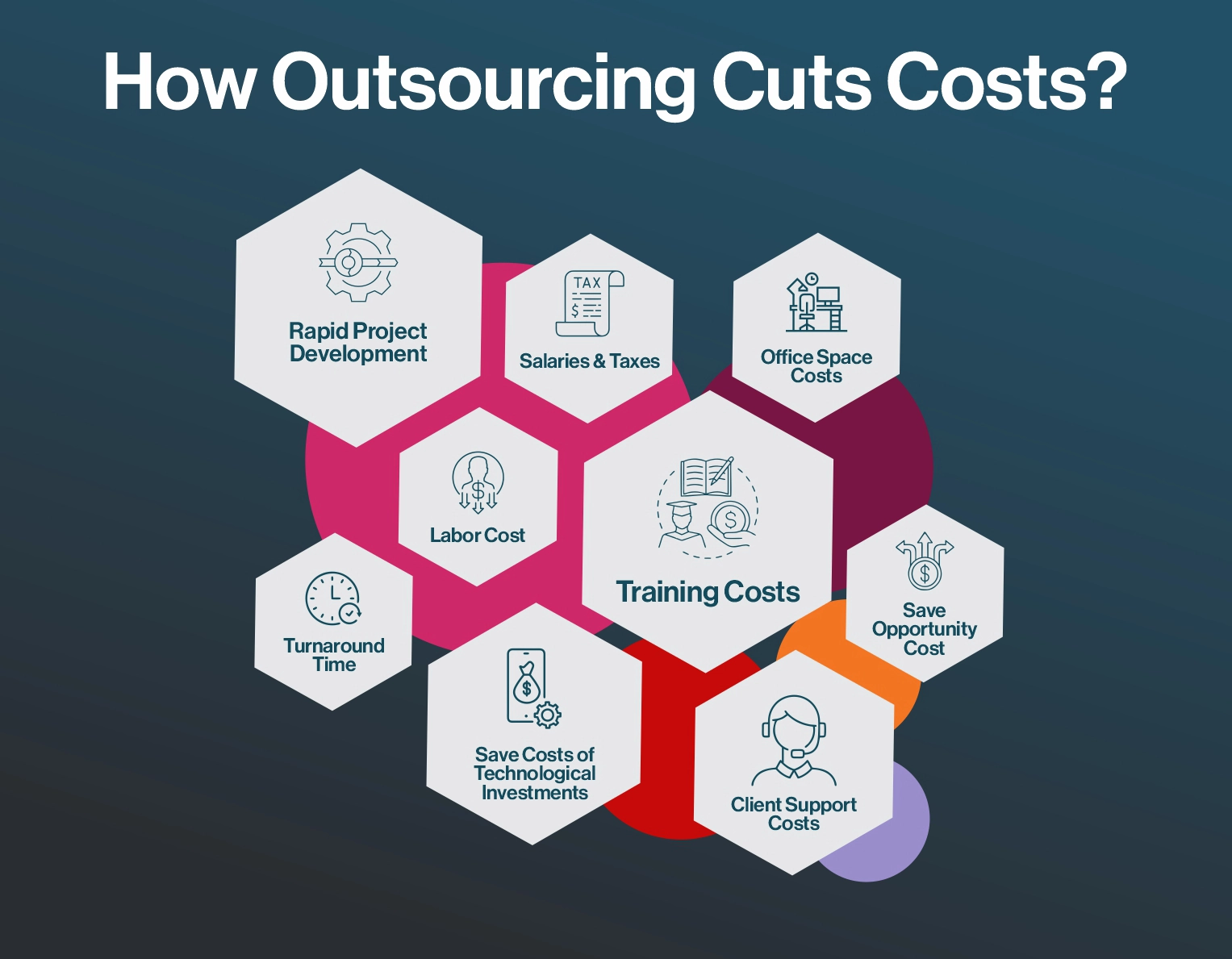The advent of global markets and rapid technological advancements have changed the way businesses work. Organizations from across the world are looking to outsource their business functions to third-party firms that can get the work done with quality but on a budget. This is one of the reasons IT outsourcing is increasing. It allows organizations to save on costs and streamline their operational workflow. Today, outsourcing has become a new normal for both small businesses and large enterprises.
Information technology outsourcing (ITO) is one prominent kind of outsourcing that involves services provided for the development of software projects, IT-resilient business processes, and infrastructure solutions. In general terms, outsourcing refers to reducing the workload that could be performed by outside suppliers and giving you the time you need to focus on your business growth. Some other outsourced IT services include:
- Mobile Application Development
- Software Development
- Technical Support
- Software Testing or Quality Assurance
In this article, we’ll discuss low-cost, the best IT outsourcing companies and how outsourcing reduces cost. So, let’s get started!
Offshore Popularity is on the Rise
Statista’s Technology Market Outlook (TMO) divides the IT outsourcing service industry into application outsourcing, administration outsourcing, IT outsourcing, and web hosting. In total, outsourcing is forecasted to make a combined revenue of 351 billion U.S. dollars in 2021. The outsourcing rate is high in America, EMEA, and the Asia Pacific regions.
According to Statistica, revenue in the Business Process Outsourcing (BPO) sector is expected to reach around US$276.1 million in 2020, with an annual growth rate of 6.7% by the year 2025. So, what else can be better than outsourcing to reduce costs?
IT Outsourcing Cost Savings Statistics
Deloitte’s 2020 Global Outsourcing Survey during the pandemic shows that despite the COVID-19 in 2020, IT outsourcing cost savings remain the primary objective of companies who are opting for this solution. In the survey, about 70% of the participants said that outsourcing is used as a cost-cutting tool. At the same time, 40% said that outsourcing assisted businesses in managing operations during the rapid operational transformation as a result of the pandemic.
In 2019, Clutch conducted a Small Business BPO Survey that concluded the main reason that businesses are outsourcing their software project is increased efficiency. About 24% of businesses said that outsourcing projects results in quality work, increased clarity, and peace of mind. 12% discussed cost reduction as a major benefit of outsourcing.
When Does IT Outsourcing Make Sense?
Outsourcing your business tasks lets you focus on what really matters while keeping costs in check. If these questions pop up while working, it might be time to consider outsourcing:
- Are we spending smartly?
- Are we using our resources to the fullest?
- Can our resources handle new tech and market competition?
- Is there a more proper and speedy way to handle things?
- Does our team have the expertise needed?
- How can we cut down on hiring and training costs?
If you want to know the difference between In-house and outsourcing software services, read our guide:
In-House Vs Outsourcing Software Development
How Outsourcing Cuts Costs?
Outsourcing non-core tasks is a money-saver for businesses. It sidesteps the need for in-house training or equipment expenses. Staff recruitment and payroll costs shrink, too. This allows businesses to concentrate on what they do best while ensuring top-notch quality in secondary operations.
Moreover, outsourcing unlocks access to specialized skills, keeping businesses competitive. It’s a gateway to global markets, expanding reach and boosting profits. Companies enjoy cost savings by outsourcing specific tasks to providers in various regions. This agility helps them swiftly adapt operations to suit market needs in a rapidly changing landscape. Let’s see how outsourcing reduces costs:
Hiring Expenses
Bringing new hires on board is a pricey affair, encompassing office setup, equipment, and added overheads like software licenses and benefits. These costs pile up, impacting on your budget significantly.
Outsourcing steps in as the cost-saving hero. By delegating these tasks, you trim expenses considerably, saving time and money.
Often overlooked, the hidden costs of onboarding can surpass an employee’s annual salary, consuming precious time and resources for hiring managers. It’s crucial to gauge these expenses, including retention costs, against outsourcing expenses.
When you tally up the expenses involved in hiring, onboarding, training, and retaining employees, the savings potential of outsourcing becomes crystal clear!
Salaries & Taxes
With outsourcing, you can reduce taxes, payroll, bonuses, and employee benefits such as paid leaves, tuition reimbursement, retirement plans, health and life insurance, etc. Also, you do not need to increase the salaries of your employees because of the inflation in each promotion cycle. Hence, outsourcing is cheaper than your overall expense of in-house development.
The wages of employees are high in Europe and the U.S. You can find outsourcing firms in Pakistan that will provide software engineers at less than 1/3rd of your current cost. An experienced resource with 5 years of industry experience will run you anywhere from 3500-4000 USD a month. That’s 20 USD/hour! This is one of the major reasons that companies prefer outsourcing their projects to countries where the cost of living is less.
Training Costs
Maintaining an in-house team aligns with your company’s values but entails higher costs to retain top talent. Competitive compensation and career growth are essential to retaining such talent, demanding investment in their development, including training expenses.
Addressing their concerns and needs preemptively is crucial to prevent disengagement. Additional incentives like hybrid work models, extra days off, and insurance are often necessary to ensure employee satisfaction.
Outsourcing cuts costs by avoiding full-time commitments and associated benefits. Software projects outsourcing companies are paid solely for the hours worked or based on agreed terms, significantly reducing financial obligations
Labor Cost
Trimming costs are a top priority when considering IT outsourcing service. Choosing project-based teams over long-term in-house staff significantly slashes expenses. You only bear the costs while tasks progress, freeing you from retaining a full team when projects conclude.
Also, leveraging wage variations across countries benefits business owners. Offshore outsourcing, especially in developing nations like Vietnam, offers savings between 30% and 90% compared to Western countries.
Well, flexibility is key. You control team size, expanding or shrinking as needed. This agility allows you to adapt to varying workloads without straining your budget, ensuring you stay nimble in a fluctuating business landscape.
Office Space Costs
Building an internal team comes with more than just salaries; it involves extra costs like office space. More employees mean more space, whether rented or purchased, demanding additional investment of time and money.
Equipping the team is another expense; data analysts, for instance, require IT tools like monitors, computers, headphones, and software licenses. More hardware also means increased energy usage.
Outsourcing tackles these expenses head-on. Tech outsourcing companies come fully equipped, eliminating concerns about office space or tool expenses. They arrive prepared with the needed facilities and equipment, lightening the financial load.
Save Costs of Technological Investments
Outsourcing reduces the cost of technical equipment. Established outsourcing companies have been working on a particular domain for a long time with all the essential tools and applications they need already set up. Outsourcing reduces costs and increases the efficiency of all development processes. You no longer have to invest in buying different types of equipment and tools for each project.
Turnaround Time
When offices in one part of the world end their working hours, offices on the other side of the world are just a few hours into their workday. Therefore, when you outsource your project, you get more work hours every day with an optimal overlap for communication. No one must wait for tasks that must be completed. By employing development methodologies such as Agile and the waterfall model of software development all the updates and work are already done for the onshore team to continue. Constant communication and collaboration enhance synchronization between both parties, ensure quality control and quality assurance, and ensures timely project delivery at a low cost.
Save Opportunity Cost
IT outsourcing swiftly delegates non-core tasks to expert third parties, freeing up your internal resources. This shift allows you to focus on core functions, channeling your capital and personnel where they matter most.
Efficiency is the name of the game. Outsourcing not only trims costs but also optimizes time utilization. Accelerating development processes helps bring products to market faster, capitalizing on market opportunities.
Moreover, partnering with the best software outsourcing companies will streamline data flow processes. Leveraging cutting-edge technology, they automate workflows, ensuring seamless operations and heightened efficiency for your business.
Client Support Costs
Hidden costs come up when relying solely on an in-house team. Providing 24/7 client support can strain resources, with added expenses for night and weekend shifts.
To sidestep these costs, leveraging external services during off-hours becomes crucial. Outsourcing to companies in different time zones ensures round-the-clock client care without extra overhead.
Also, tapping into regions with lower labor costs through outsourcing grants access to skilled employees at reduced expenses, maintaining service quality while saving money.
If you want to know how outsourcing helps in SaaS product development, then you can read our guide:
SaaS Product Development Benefits
How Much Do Businesses Save by Outsourcing?
Quantifying savings from outsourcing isn’t exact. The International Organization for Standardization (ISO) notes an average cost reduction of around 15% through outsourcing.
However, actual savings hinge on the scope of outsourced operations and internal adjustments. The Harvard Business Review suggests 20% to 30% potential cost cuts when outsourcing non-core tasks like billing, payroll, recruitment, and lead generation.
Save More with Low-cost IT Outsourcing Countries
Low-cost country sourcing (LCCS) is a strategic business approach companies adopt to curtail production expenses by leveraging countries like China, Malaysia, Pakistan, and Indonesia. This tactic banks on several key advantages:
Cost Efficiency
One primary rationale behind LCCS is the cost discrepancy. Countries with lower salary expectations and currency rate differences offer significant savings in production costs. For example, the average annual cost for software development in the US amounts to around USD 86,800, whereas in Malaysia, it stands at approximately 79,300 RM/year (equivalent to USD 18,872).
Skilled Labor Pool
Developed nations often outsource tasks like software development and customer support to low-cost countries for their skilled yet cost-effective workforce. Governments in these nations invest in technical education and proficiency, ensuring a robust pool of skilled labor for outsourced projects.
Raw Material Access
Outsourcing production to regions where raw materials are sourced benefits both developed and low-cost countries. It reduces transportation costs for developed nations and stimulates employment and economic growth in low-cost nations.
24/7 Availability
Outsourcing customer service to countries in different time zones allows companies to provide round-the-clock support. This availability grants a competitive edge and ensures uninterrupted service, improving workflow efficiency.
Scalability Opportunities
Offshoring opens doors to new markets, facilitating the expansion of consumer bases for companies. Businesses explore and tap into new markets starting with one department, eventually outsourcing additional functions, reducing costs and expanding their global presence.
Hire a Trustworthy IT Outsourcing Partner
Several key factors can help you make an informed decision when searching for a reliable outsourcing partner. Firstly, evaluate the range of services offered by different outsourcing companies. Some provide comprehensive services, while others specialize in specific areas. Understanding their service spectrum aligning with your needs is crucial.
Customer feedback is a valuable resource in assessing the credibility of potential partners. Reading reviews, testimonials, or case studies can offer insights into their strengths and weaknesses. This aids in gauging their track record and reliability before committing.
Assess the experience level and expertise of the outsourcing company’s employees. Inquire about their skill sets, qualifications, and previous projects to ensure they align with your requirements. Understanding the type of work they specialize in helps determine the quality of their output.
FiveRivers Technologies is a company in Lahore, Pakistan that has provided this very service for over 20 years to clients in Europe and the USA.








